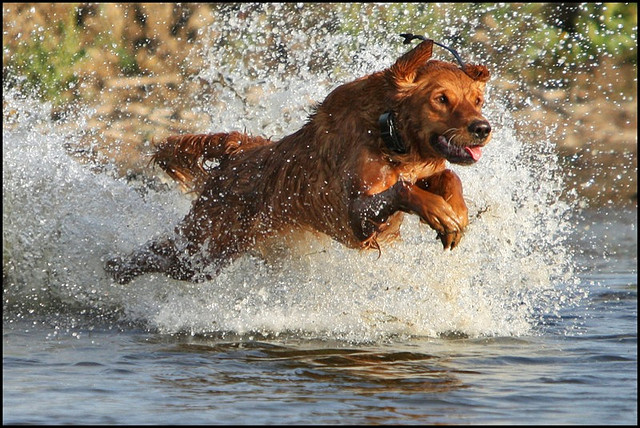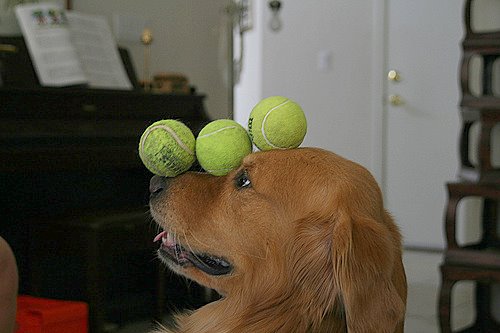Golden Retriever training is a vital part of turning this intelligent, inquisitive puppy into a well-behaved adult dog. Training time gets more sophisticated as the pup gets older. The important thing is to provide an outlet for the Golden’s energy and set boundaries so they know what is allowed and what isn’t.
1. When to start Golden Retriever training
Start training your Golden Retriever puppy when he is seven weeks old. He’s already begun to pick up lessons from mom, and now he’s ready for his human’s input. There’s so much to see and do in his new world, so plan for a short attention span. Teach the following five obedience commands early to make further training simpler:
- Sit.
- Down.
- Come.
- Stand.
- Stay.
2. Who am I
Teach your puppy his name. If you’ve adopted an older dog, ask if there’s a name he responds to before giving him a new name. You must get his attention before he’ll learn and respond to commands.
3. Short commands are beneficial
One-word commands are easier for the pup to understand and obey. The examples above involve motion that can be directed to help understanding.
4. Set a schedule designed to produce results
When you’re training your pet you need to keep in mind that dogs have a very short attention span. Therefore, during the training session, you need to make sure that you have achieved as much as possible. When your pet loses attention during the training session, you can always stop and continue on another day. Make sure your pet absorbs as much as possible within the shortest time and your training sessions will be successful.
Plan short training times during the day and evening. Aim for 15 to 20 minutes total each day for formal training. Puppies continue to learn through everyday experiences. Keep a steady regimen of training, but don’t turn it into work. The puppy needs a break now and then and so do you.
5. Respect
Make sure your pet learns to respect you. The dog must always see you as a leader, at all times. When your dog respects you, it will always do everything that you say. For instance, if you command your pet to lie down or stop doing something, it will immediately do so without question. The first lesson your dog must learn is respect, especially if you want the lessons to go off without a hitch. You must take the strong and assertive position for the pet to respect you.
6. Rewards
One of the epitomes of training your pet is getting the best rewards. Therefore, if you want the training to go off without a hitch, you need to find the right reward for your pet. Every pet is different, so you need to find something that your pet actually appreciates. You can get this information by finding out what your pet seeks during every training session.
7. Goldens are never too old to train
All training, including Golden Retriever training, requires time and consistent refreshers. Don’t assume that the adult Goldie you adopt has the social skills you expect. Dogs learn proper behavior from their human family. If they’ve been on their own for some time, teach by example. Friendly, loving, and eager to please, your furry friend wants to please you by his actions. Work on one or two activities at a time and praise him lavishly when he’s successful.
8. Obedience training is Important
Help your puppy or dog stay safe and avoid bad social behavior with three essential obedience commands. There will be times when reinforced Golden Retriever training keeps your dog from harm, such as returning to your side instead of running into the street. Use the following commands each day, using the dog’s name so he knows it is directed to him.
(Dog’s name), sit!
(Dog’s name), come!
(Dog’s name), stay!
Reward a quick response with praise, a toy, or treat. That reinforces the behavior. Avoid any loud or threatening action.
9. Collar training
Getting used to wearing a collar is an important part of Golden Retriever training. Keep the collar in plain sight so your puppy is used to seeing it. He’ll probably want to sniff it first. Be sure you’ve handled it already so it has a familiar, friendly smell. Put the collar around his neck and fasten it. Anticipate resistance. Distract the pup by tossing a ball to him or some other game he enjoys. After a short time, remove the collar and place it on a shelf where he can see it without being able to reach it. Repeat a few times a day to get him used to the procedure and feel of the collar.
Skip collar training during times when your puppy is excited, unhappy, or stressed.
10. Leash training
Once the puppy accepts the collar being put and left on for a short time, you can start leash training. Attach the lead to the collar before putting it on the pup. Let him smell and examine the lead. Then put the collar on, holding the leash to the side so it doesn’t frighten him. Start with short sessions until your Golden accepts this new process. It will help him anticipate leash time instead of avoiding it.
11. House Training
Golden Retriever training doesn’t always include house training, as your pup may have learned this important task before joining your family. Like their wolf ancestors, dogs instinctively know they should relieve themselves away from their den (your house). Cleanliness keeps their scent from being detected by predators, so it’s a survival instinct. Crates, papers, and puppy pads for common methods for housetraining puppies, and really becomes a matter of which you prefer.
12. Socialization
Teaching your pup socialization skills is critical. Golden Retriever training is designed to address the enthusiastic, inquisitive nature of this breed. Even at 6 weeks of age, the pup is accepting a variety of new friends, including cats, other dogs, and members of his new human family. Promote the behavior you wish him to exhibit as he grows in both size and experiences over the next few months. Let him accompany you for walks and take him to the park. Keep him secure when he goes for a ride. Guard him carefully so he is not frightened or harmed while socializing.
Praise well and often during training. Reinforce what’s been learned. Scratch behind his ears or pat him on the hip when he’s behaved properly. Happy experiences encourage well-behaved dogs of all breeds.


